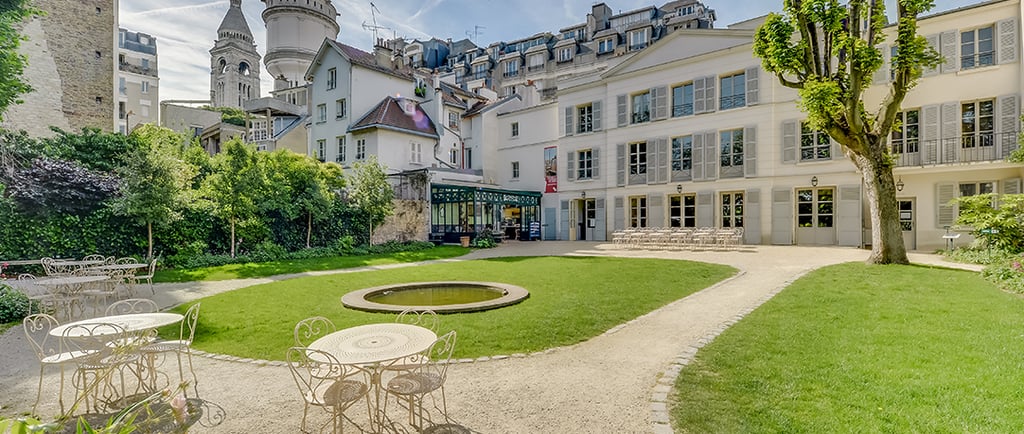Musée de Montmartre
6/4/20255 min read


The Musée de Montmartre: a journey through Parisian art and history
Nestled in the heart of the historic Montmartre district, the Musée de Montmartre offers a captivating glimpse into the bohemian spirit of Paris at the turn of the 19th and 20th centuries. As one of the most charming and unique museums in the French capital, it highlights the rich artistic history of Montmartre, a district once home to some of the world’s most renowned artists. Through its exhibitions and its beautiful setting, the museum transports visitors to a time when Montmartre was the epicenter of creativity and artistic rebellion.
A historic setting: the former home of artists
The Musée de Montmartre is housed in the former residence of many artists who lived and worked in the district, including Auguste Renoir, Dmitri Sorokin, and Émile Bernard. The museum occupies several buildings that date back to the 17th century, making it a part of Montmartre’s deep historical roots. The most famous of these buildings is the Bateau-Lavoir, a former workshop that became a gathering place for famous artists like Pablo Picasso, Georges Braque, and Juan Gris. It was here that Picasso painted some of his earliest works in the Cubist style, marking the district as a birthplace for some of modern art’s most transformative movements.
Montmartre has long been known as an artist's haven, offering a bohemian atmosphere with its cobblestone streets, charming cafés, and panoramic views of Paris. The Musée de Montmartre allows visitors to step back in time and explore the district’s artistic legacy in the very space where these influential works were created. Walking through the museum’s halls is like walking through an artist's dream, with each exhibit telling a different chapter in the story of Montmartre’s colorful past.
The museum’s permanent collections: a tribute to Montmartre’s artistic legacy
The permanent collections at the Musée de Montmartre delve into the rich history of the district’s artistic scene, with a focus on the artists who called Montmartre home and the vibrant culture that flourished here during the late 19th and early 20th centuries. One of the highlights of the collection is the museum’s homage to the famous French artist Henri Toulouse-Lautrec, who is often associated with Montmartre and the lively world of cabarets and cafés. Lautrec was inspired by the district’s nightlife, particularly the Moulin Rouge, a famous cabaret that is now an iconic symbol of Paris.
Lautrec’s works, particularly his posters and paintings of dancers, performers, and cabaret scenes, capture the energy and decadence of Montmartre’s entertainment scene. The museum houses a number of his paintings and prints, showcasing the artist’s mastery of color and his ability to depict the dynamic nature of Parisian nightlife. Other renowned artists, such as Maurice Utrillo and Amedeo Modigliani, are also featured in the museum’s collection, further highlighting the artistic diversity that Montmartre attracted.
The museum also explores the district’s connections to the world of literature and music, with exhibitions dedicated to famous writers and musicians who frequented Montmartre, such as Marc Chagall and Erik Satie. The legacy of these creative minds is an essential part of Montmartre’s cultural identity, and the museum does an excellent job of showcasing how this environment nurtured artistic expression across all mediums.
A unique garden: a window to Montmartre’s past
One of the hidden gems of the Musée de Montmartre is its beautiful garden, which provides a rare and peaceful retreat from the bustle of Paris. The garden was once part of the Clos Montmartre, a vineyard that dates back to the 12th century and was used for wine production until the early 20th century. The vineyard was one of the last remaining in Paris, and the wine produced here was once served at local cafés and bistros.
Today, the garden offers visitors a chance to enjoy a lush and tranquil space, surrounded by the artistic atmosphere that has defined Montmartre for centuries. The garden is carefully maintained and features a variety of plants and flowers, providing a glimpse into what Montmartre must have looked like in its earlier days. In the spring and summer, the garden comes alive with vibrant colors, making it a popular spot for visitors to relax and reflect on the artistic history they have just explored in the museum.
Temporary exhibitions and cultural programs
In addition to its permanent collection, the Musée de Montmartre regularly hosts temporary exhibitions, which explore different aspects of the district’s rich artistic history. These exhibitions often feature works by contemporary artists, alongside retrospectives on historical figures who have had an impact on Montmartre’s cultural development. The museum also organizes workshops, lectures, and special events, providing a platform for visitors to engage with Montmartre’s history in a more interactive way.
The museum’s temporary exhibitions span a wide range of topics, from showcasing lesser-known artists who worked in Montmartre to exploring the connection between the district and the avant-garde movements that emerged in the early 20th century. This dynamic approach ensures that the Musée de Montmartre remains relevant and exciting for both art lovers and those with a general interest in the cultural history of Paris.
Montmartre and its influence on the art world
The story of Montmartre is inextricably linked to the development of modern art. During the late 19th century, the district became a melting pot for artists from all over the world, drawn to its affordable rents, vibrant social scene, and inspiring environment. Montmartre was home to the Bateau-Lavoir, an artists’ studio that became a symbol of the neighborhood’s artistic energy. Here, artists such as Picasso, Georges Braque, and Fernand Léger worked alongside writers, musicians, and poets, creating a creative community that would shape the future of modern art.
The influence of Montmartre can still be seen today in the works of contemporary artists who draw inspiration from the district’s unique character and history. The museum’s exhibits pay tribute to the lasting impact of Montmartre on the global art world, making it an essential stop for anyone interested in the development of modern art.
A visit to the Musée de Montmartre: an unforgettable experience
The Musée de Montmartre offers a unique opportunity to step into the history of one of Paris’s most famous neighborhoods. Whether you are an art enthusiast, a history lover, or simply someone looking to explore the charm of Montmartre, the museum provides a fascinating and immersive experience. From the beautiful garden to the captivating exhibitions, the Musée de Montmartre allows visitors to discover the stories and art that shaped this iconic district.
Located just a short walk from the famous Place du Tertre and the Sacré-Cœur Basilica, the museum is an essential stop for anyone exploring Montmartre. The museum’s intimate atmosphere, combined with its rich cultural history, makes it a must-visit destination in Paris. For those who are passionate about art and history, the Musée de Montmartre is not just a museum – it is a journey through time, offering a deeper understanding of the creative soul of Paris.
Conclusion
In conclusion, the Musée de Montmartre is a beautiful tribute to the artistic heritage of one of Paris’s most iconic neighborhoods. Its carefully curated collections, along with the museum’s historic setting and peaceful garden, provide a unique opportunity to explore the cultural legacy of Montmartre. From the bohemian artists of the late 19th century to the modern artists who continue to draw inspiration from the district, the museum serves as a bridge between the past and present, offering visitors a rich and immersive experience. Whether you’re an art lover or simply curious about the history of this fascinating area, the Musée de Montmartre is an essential part of the Montmartre experience, and a true gem in the heart of Paris.
If you need assistance finding your dream pied-à-terre in Paris, contact us to learn more about our services.


